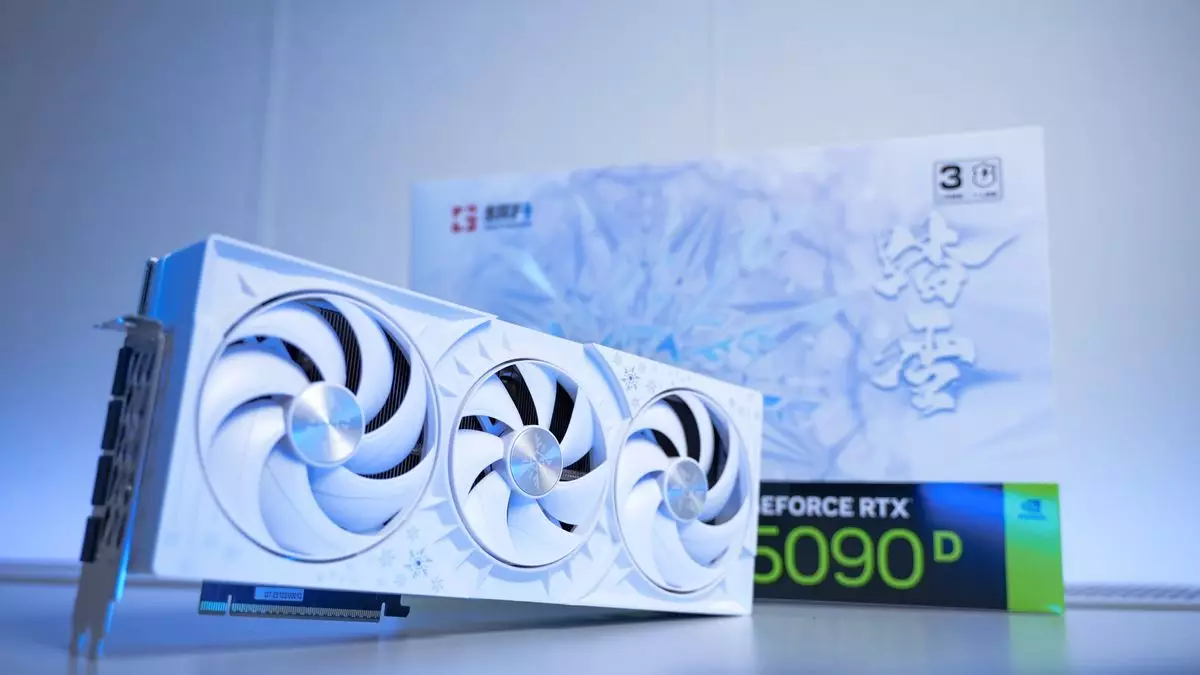As the anticipation builds around the launch of the Nvidia RTX 50 series graphics cards, Gainward has unveiled a visually striking version—the RTX 5090 D. This model stands out due to its frosty, all-white design adorned with delicate snowflakes and sharp thorns encircling the central fan. While some may find the bold branding of Gainward, plastered across the card’s surface, to be excessive, it’s hard to ignore the allure of a graphics card that looks both elegant and fierce. This aesthetic appeal is particularly significant in a gaming landscape where hardware is becoming as much a statement piece as it is a practical component.
Understanding the D Series: Performance Limitations Explained
However, like many allurements, the RTX 5090 D does come with caveats. This particular model represents a workaround to comply with export restrictions imposed by the US government on technology affiliated with AI and cryptocurrency. These limitations first surfaced with the RTX 4090 D cards, and they impose a cap on peak computing performance, thereby ensuring that the 5090 D won’t be as powerful as its RTX 5090 counterpart. Such restrictions can limit the total processing performance (TPP) and performance density (TD), creating a significant distinction for users who seek maximum power for demanding tasks.
The irony, of course, is that while companies like Gainward may try to navigate these market barriers creatively, they simultaneously highlight the ongoing tensions between tech giants and regulatory bodies. The complexities of international business can obscure advancements in technology, distorting what should ideally be a seamless user experience into something affected by geopolitical machinations.
When examining the specifications more closely, the RTX 5090 D has some promising elements despite the performance restrictions. With 32 GB of GDDR7 RAM and 21,760 CUDA cores, it mirrors its non-D counterpart in these key areas. However, the looming question remains: Will this hardware endure the limitations imposed by compliance with US laws? Until Gainward releases comprehensive performance benchmarks and retail pricing details, enthusiasts are left with a veil of uncertainty.
This ambiguity contributes to the growing frustration among consumers who crave clarity on gaming hardware. Performance enthusiasts often invest significant resources into acquiring state-of-the-art technology. Uncertainty surrounding the potential of the RTX 5090 D can undermine consumer confidence and shift focus away from its visual charm.
The Market Reaction: Aesthetic Appeal vs. Raw Power
Gainward’s RTX 5090 D might not only attract gamers interested in its aesthetic qualities; it can also spark curiosity in collectors or those fascinated by limited-edition tech. The urge to possess hardware that is unique, like the RTX 5090 D with its frosty uniqueness, runs deep among certain consumer segments. This mentality is echoed by the tech community’s adoration for other China-exclusive gaming products, such as Razer’s collaborations with Pokémon and the Evangelion-themed OneXPlayer devices. The available aesthetic options often stir excitement, even when they are not accessible in every region.
As the industry continues to evolve, the differentiation between what is available in different markets will probably become more pronounced. Consumers are likely to demand not just capability but also individuality in the technology they choose to invest in.
As anticipation mounts for the RTX 5090 D, one can’t help but hope that the striking design will eventually be made available in more markets, possibly even in a non-D variant that reflects the same aesthetics without the performance compromises. The ever-changing landscape of gaming technology suggests that the demand for visually appealing products will continue to rise, galvanizing companies like Gainward to innovate.
While the Nvidia RTX 5090 D is visually captivating, its status is tempered by performance limitations and market accessibility issues inherent in the current tech landscape. However, the ongoing dialogue regarding aesthetics versus functionality will likely continue to shape consumer preferences and market trends in the years to come. The dream of security while packing power with an appealing design remains a tantalizing prospect for tech lovers across the globe.

